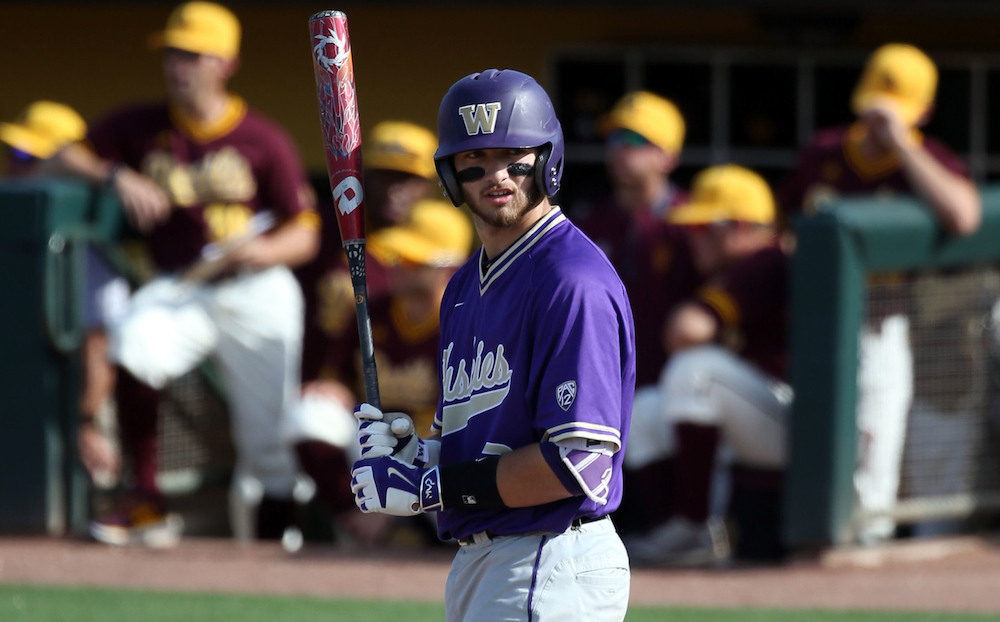Feature Photo: Joey Morgan, C, Tigers
(with University of Washington)
Last week, I was able to travel up to Dodd Stadium in Norwich, CT to start taking some looks at the Short-Season A New York-Penn League, starting with a two-game set between Triple-A Tri-City (HOU) and Connecticut (DET), and focusing on three Tigers’ prospects. While it was a short look, right-handed reliever Wladimir Pinto was looking good for the Tigers, flashing the stuff of a future Role 60 set-up man; right fielder Reynaldo Rivera’s above-average hit tool and near-elite raw power were both on display, and 2017 third-rounder and catcher Joey Morgan looked good behind the dish, though his hit tool may hold back the profile.
2080 Prospect Spotlights
Short-Season A New York-Penn League
Tri-City ValleyCats (HOU) vs. Connecticut Tigers (DET)
June 28-29, 2017
 Wladimir Pinto, RHP, Tigers (Short-Season A Connecticut, New York-Penn League)
Wladimir Pinto, RHP, Tigers (Short-Season A Connecticut, New York-Penn League)
Ht/Wt: 5’11”/170 lbs. B/T: R/R Age 19y, 1m
Pinto, while still young, is a very projectable right-handed power arm who has a future as a late-inning set-up man thanks to his big fastball and developing secondaries. Signed as an undrafted free agent out of Venezuela in 2014, He looks to be playing about 10 pounds above his listed weight and has a strong, compact frame. I was able to view a one-inning relief appearance on June 28 where he did not allow a hit, and struck out one batter.
Pinto works from the stretch, and has a quick arm action. He is a long-armer with a full arm circle, and he is able to get some good angle despite his size by delivering from a high-3/4’s slot. The fastball is a weapon, sitting at 95-to-97 mph with most readings at 96 mph, and he’s able to bore it into righties with late life and ride and plus movement. His command is average, and he’s comfortable pitching to both sides of the plate with the offering. His curveball is presently his best secondary, showing depth and spin with good feel, and it projects to be an above-average pitch with developing two-plane depth, and more of a slider quality to it. He does throw a changeup, and he showed some feel for it in warmups, but it was not used in-game.
His potential will be closely tied to his refinement of the secondary offerings to play up the double-plus fastball, as well as reigning in the overall control profile, which is improving with experience and growing confidence working in-zone. He’s still thrown just 55 2/3 pro innings, but his walk rate is dropping (9.1 BB/9 2015, 3.80 BB/9 2016, no walks in 4 1/3 innings this year) while his strikeout rate is climbing (7.94 SO/9 in 2015, to 12.41 SO/9 in 2016, 8 strikeouts this year). If the refinement of the secondaries develops as he builds innings – and I am confident they will – he is a good bet to project as Role 60, late-inning set-up man, with the double-plus fastball carrying him in the role.
 Reynaldo Rivera, RF, Tigers (Short-Season A Connecticut, New York-Penn League)
Reynaldo Rivera, RF, Tigers (Short-Season A Connecticut, New York-Penn League)
Ht/Wt: 6’6”/250 lbs. B/T: L/R Age (As of April 1st, 2017): 19y, 9m
Taken by the Tigers in the second round of the 2017 MLB Draft out of Chipola C.C. (Marianna, FL), Rivera is coming of a NJCAA National Championship season for the Indians, where he hit .397 with 10 home runs and 67 RBIs, while working 29 walks in 184 at-bats. He spent the season mostly playing first base, but has moved to right field for the Tigers, and he should acclimate well there thanks to his well-proportioned, athletic frame and build, but he will need to manage the body, as there isn’t much room for any added weight.
Rivera shows solid barrel control and has a good swing path with above-average bat speed. He can stay inside the ball and manipulate the barrel to use all fields well, and he barrels balls up with strength, loft, and leverage in the swing. He showed off near-elite graded raw power in his BP sessions, getting the barrel out and hitting the ball with authority. He came into the pro game with a good sense of plate discipline, and that is playing out in his short time with the Tigers, as in my two-game view (a doubleheader) he was a combined 3-for-4 with a pair of walks, a home run, a double, and five RBI’s. Overall, the hit tool is an impressive package, and he projects to hit for some average (.260-.265) while bringing plus to double-plus power potential.
In the field, he’s an average defender who is still raw playing in right field, but he showed an average glove and average range that should improve to above average as his reads and reactions improve, both into the gaps and to the line. His arm is above average, with a solid throwing action and good carry on his throws. The only concern with his development in the outfield is managing his weight so as not to force a move back the first base, which is not necessarily a step back, as he shows the athleticism to handle the position at least an average level should a move be necessary. On the bases, he’s not a baseclogger and he has good instincts, but his overall speed is well-below average, though it plays slightly better once underway in the field.
With developmental time taken into account on defense, I see a projectable, above-average hit tool with double-plus (30 home run potential) power who just needs some refinement in right field to reach his potential, which adds up to a moderate-risk ceiling of a Role 60 right fielder in the big leagues.
 Joey Morgan, C, Tigers (Short-Season A Connecticut, New York-Penn League)
Joey Morgan, C, Tigers (Short-Season A Connecticut, New York-Penn League)
Ht/Wt: 6’0”/185 lbs. B/T: R/R Age (As of April 1st, 2017): 20y, 8m
Morgan was taken in the third round of this year’s MLB Draft out of the University of Washington who has the look of a future Role 40 backup in the big leagues, with his hit tool limiting the profile based on my looks last week.
Morgan looks heavier than his listed weight, giving him a sturdy, compact frame that fits the position well. In BP sessions and in-game, he had an inconsistent swing path: at times showing some length to it, as well as some bat drag, and in other swings taking a shorter path to the ball with average bat speed and showing the ability to shoot the gaps. It’s more of a line-drive swing, but he can flash average pull-side raw power, but I don’t see that translating into game power at much more than a below-average level.
Behind the dish, he looks the part of an average, catch-and-throw defender with good receiving actions, footwork, and agility behind the plate. He can frame pitches well, and was comfortable handling high-velocity offerings (including Wladimir Pinto’s 96-mph fastballs), and he shifted well, with average range and blocking ability in this viewing.
The below-average hit tool will hold back the profile from an everyday major league role, but there is enough on the defensive side of the ball to hold down a Role 40, backup role in the big leagues, with the ability to carry the position for an extended period of time if he’s called upon.


